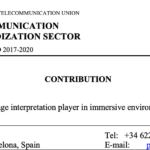There are currently four different options to view immersive content: An immersive VR headset in combination with a powerful PC or games console, VR viewer with a mounted smartphone, a smartphone itself and a web video player.
The user experience varies between these options, for instance the level of immersion is very high when using a VR headset. The access to and control of the omnidirectional content is different from device to device.
Using a VR headset to consume 360° content is a real challenge for some people. There are side effects like motion sickness which might be reduced through multiple usage or just by sitting while consuming the content. The experience of hearing the sound of a 360° space while being isolated from the outside environment increases the feeling of immersion, the users feels like part of the story.
In ImAc we want to extend this experience to people with disabilities by enhancing the content with accessibility services. Following a user centric design approach, several project partners conducted focus groups to identify the user needs.
At RBB (Rundfunk Berlin-Brandenburg) we focused on end users with hearing loss and their needs for subtitles and signers in 360° content.
We showed a 360° video in a web video player on a PC and in a VR headset. None of the users had tried using a VR headset before the focus group. It emerged that users with hearing impairments often have balance disorders and the effect of motion sickness occurs faster. We observed that the users only made tentative head movements. Additionally, the usage of a VR headset hinders sign language communication and the user was left alone with the experience and the control of the video. The parallel usage in a group with several VR headsets or different devices was considered unlikely, the TV or the PC was more preferred in this use case.


